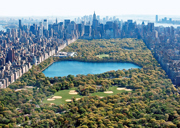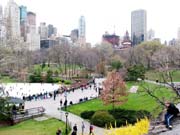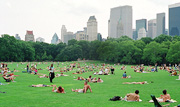If you think of five things that can be done outdoors, chances are at least four them can be done in New York City's Central Park. This haven for outdoor fun has room for practically everything in its 843 acres of paradisiacal nature. Running from Eighth Avenue to Fifth Avenue and from 59th Street to 110th Street, it's located literally in the heart of New York -- it actually looks as if somebody had mowed the skyscrapers and a beautiful garden had grown in there.
Here is a guide of things to do in it:

Whether you are a bird-watching aficionado or just curious and want to give it a try, you can always visit The Ramble, a popular section of the park inhabited by many species of woodland birds. The sound of warblers during the Spring and Fall is just as New York as the Chrysler Building. Or you can have the most perfectly romantic date of rowing a boat from the Loeb Boathouse and then eating at the restaurant overlooking the lake. Or you can ride a carriage horse just to feel like a millionaire from the 1800s on his day off -- or take the more modern, animal friendly alternative, the pedicab (in which the horse is substituted by a bicycle).
But more importantly, you should visit the 6-mile long Park Drive. It doesn't matter if you are not into sports, the sheer awe-inspiring enormity of it is reason enough to see it.
It speaks volumes of the New York mentality, how a crowded city has made room for such a big area where its citizens can take a break from the urban chaos around them and pretend they are miles away from the madding noise and participate in races during the weekend (especially the USA Men's 8k Championships), climb the park's glaciated rock outcroppings (for that, you can visit the various animal-named rocks: Rat Rock, Cat Rock, Dog Rock, Duck Rock or Beaver Rock), or just gracefully glide through its ice skating rinks.

Children will definitely appreciate the over twenty playgrounds located through the parks. Well-known philanthropist August Hecksncher broke the ice in that department by donating the first playground -- an impressive 3-acre homage to the importance of playing which no child visiting New York can do without.
For a more spectacular evening with children, the 1951 Central Park Carousel is a safe bet -- not only is it one of the largest merry-go-rounds in the United States, it also is a piece of history made of pieces which date back from 1908. Just think of all the children that have spent time in them. The Swedish Cottage Marionette Theater (which reasonably hints at its location in the Swedish Cottage) has also been amusing children since 1877, so it is at least historically interesting to visit.
The safest choice of all, though, is always the Central Park Zoo if only for the chillen penguin house and the Polar Bear pool.
Central Park is a monument to the heterogeneity that beats at the core of New York. In fact, it's a not-so-pocket-sized metaphor for the city itself.
It was conceived by wealthy residents, who were inspired by what they had seen elsewhere -- parks in London and Paris in the case of Central Park, trade cities in the case of New York. The foreign idea then went on to the hands of American politicians, who agreed that the rocky, swampy and inhospitable piece of land that nobody had constructed on would make for a much-needed open space in the heart of the city (as well as a healthy alternative to pubs).
American politicians, then, greenlit the project and hired a British mind, designer Calvert Vaux's, to define it and bring it to fruition. Again, not unlike New York.
The analogy continues as the site started to get crowded with about 20,000 workers turning the terrain into a perfect park unlike anything else in the world. It was an enormous team effort. There were Yankee engineers, Irish laborers, German gardeners and native-born stonecutters. They moved 3 million cubic yards of soil and planted more than 270,000 trees and shrubs. When the park opened in 1859, its visitors were counted by the millions -- seven per year to be precise.
It also created a classic New York sight -- people skating under the snow with the New York City skyline in the background. It would become a staple for the park's identity in 1949, when the Wollman Skating Rink was constructed, but for the time being, the swamps-turned-into-lakes did just as fine.

In fact, most of the park's attractions were still to come, but they didn't take too long -- concerts on Sundays in the 1880s, a Carousel, goats to ride on and the local's favorite -- the Zoo.
A German-born millionaire, August Heckscher, donated the park's first equipped playground in 1927. As Central Park was consolidated as New York's lung, it kept on expanding in the 1950s and early 1960s through private investments: the aforementioned Wolfman Skating rink allowed people to skate in the winter and see concerts in the summer.
The Lasker Rink Pool, donated by Albert Lasker, perhaps America's favorite advertiser before Don Draper, provided an opulent pool in the summer where many New Yorkers have learned to swim as children. The octagonal Chess and Checkers House allows strategy aficionados to hone their skills all year long. And so on.
And yet, historical parallelisms aside, what makes Central Park so much like New York is that, despite thriving on private money and foreign ideas, both are shaped by the public that lives it.